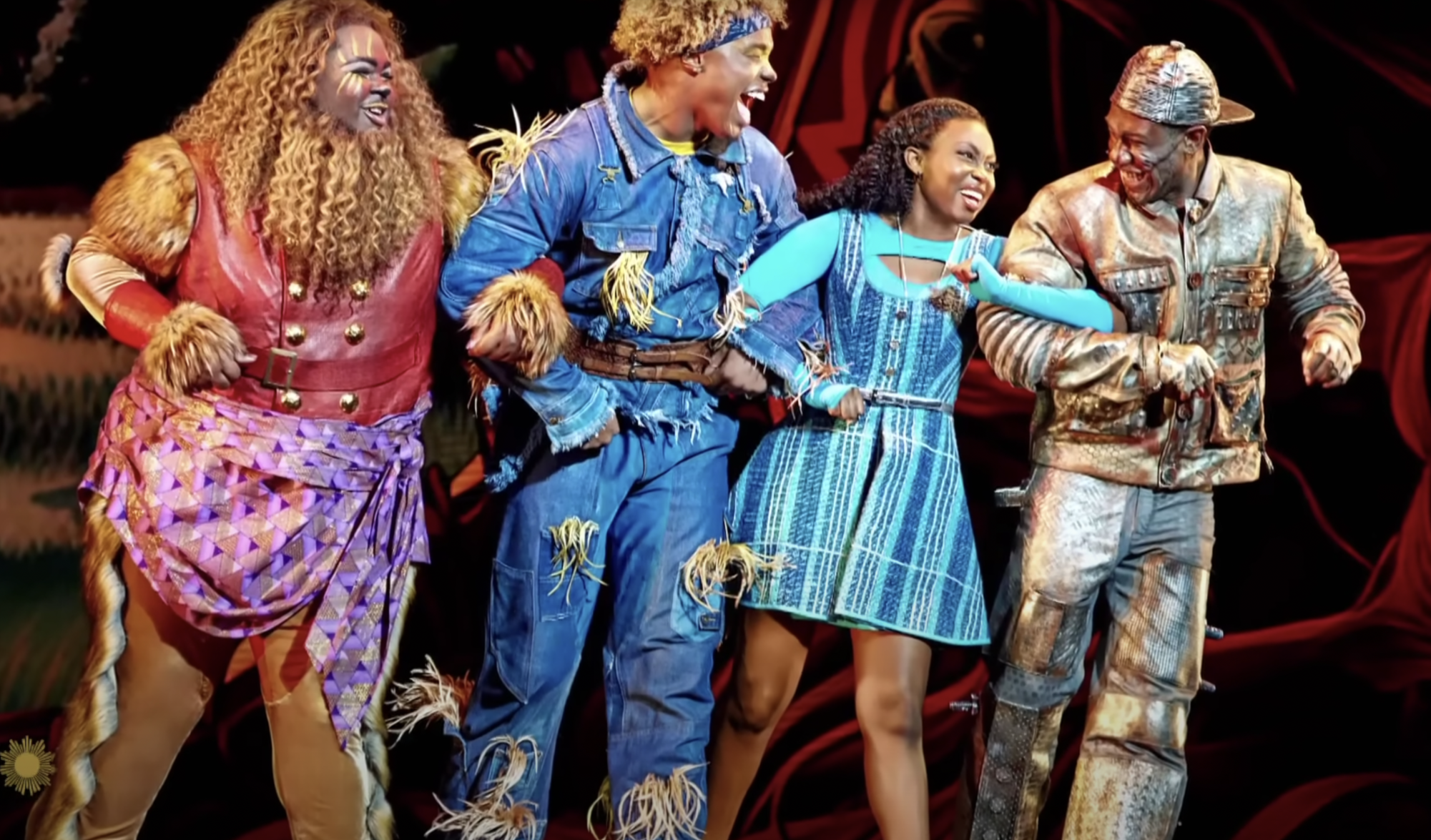It’s time to Ease On Back Down the Road!
Broadway producer Kenneth Harper wrote “The Wiz” directly based on the original “The Wizard of Oz” in 1972. He wanted to do an all-black version of “The Wizard of Oz” and produce it on a Broadway stage.
At first, Harper went to Geoffry Holder, a Trinidad-American actor and dancer who began his career at The Metropolitan Ballet. Although Harper was looking for recommendations of Black directors that would benefit the project, he ended up overlooking Holder as a potential director.
Although Holder was passed up initially, he still dreamt up the entire show, from its impressive costumes and ballet dances to its soulful music. It was beyond anything creator Kenneth Harper could have envisioned. After showing Harper his vision for the show, Geoffry Holder soon became the costume designer and director for the Broadway show.
Yet the stage show was a flop. Every week, it was losing more money than it cost to produce. It was hard to get white theatergoers in seats. It was geared more toward the Black community and veered far from the traditional theater of the 1960s and ‘70s, when more emotional and ballad-heavy musicals centering around historical events were popular.
Desperate to save the show, Harper turned to television advertisements. The ad featured a short snippet of the classic and catchy tune “Easy On Down The Road.” The advertisement was blasted during prime time television and the song became a chart-topper.
The show’s appealing advertising helped fill just about every seat.
Just three years later, in 1978, “The Wiz” made its way to the big screen, featuring an iconic cast including Diana Ross, Michael Jackson, Nipsey Russell and Ted Ross.
Recently, sophomore performing arts student Melissa Ocegueda saw the film version of “The Wiz” for the first time in her Intermediate Theatre Class. She felt the movie was full of color and one of a kind, in comparison to other musical movies she’s seen before.”
“It was one of the most energetic movie musicals I’ve ever seen,” Ocegueda says. “The songs and dances were mesmerizing!”
The movie was created with an Afrofuturism aesthetic, and the changes made from stage to screen reflected this. Dorothy Gale was now a kindergarten teacher, played by Diana Ross, and Oz was based in Harlem. The crucial setting change helped solidify the aesthetic.
Afrofuturism is the blend of traditional African culture with science fiction and fantasy. “The Wiz” heavily leaned on this idea of blending the old with the new. It championed the unique culture and music of African Americans. The songs took heavy inspiration from R&B, gospel and choir music.
“The Wiz” abandoned other traditional theatre “norms” in the style of costume and makeup. Most costumes for “The Wiz” were comprised of bright colors, African prints and bell bottoms. Natural hair and a wide variety of protective hairstyles were highlighted. Traditionally, musicals in the Post Contemporary era, from 1970 through 1999, had more minimal costumes, with both male and female actors keeping minimal hairstyles and clothing.
One of the more popular and previous Broadway shows, “Grease” (1972), vastly opposes the costume design of “The Wiz.” “Grease” played it safe with denim jeans, circle skirts and now-iconic jackets. In comparison, “The Wiz” blew “Grease” out of the water in terms of costumes. “The Wiz” turned the once mundane Broadway scene and brought it to life with color.
Holder pulled influences from his Trinidadian culture to create most of the costumes. Never before had Caribbean culture been shown on Broadway. Holder also took color inspiration from his home country in his vast use of colors and flashy clothes.
While Holder highlighted Caribbean culture, he also took costume inspiration from African-American culture.
The greatness of the costumes was the blend between both sides of African-American culture. It made space for the African Diaspora to blend with the modern Black world. Queer ballroom dance and ballet blend together where Broadway ballads met soulful R&B songs. Holder saw the importance of the glitz and glamor but also the reality of African Americans in the ‘70s. He wasn’t afraid to completely ignore white fashion and culture to champion his own.
Tony award-winning shows such as “The Lion King” and “Once On This Island” would never have had the space to exhibit the beauty and vastness of African and Caribbean culture if it wasn’t for “The Wiz.”
Before “The Wiz,” the Black presence in the theatre had been virtually nonexistent. The closest thing to the “Black experience” on stage was exaggerated and stereotyped by blackface. 1921’s “Shuffle Along” and 1927’s “Showboat” are the most notable Broadway productions that featured blackface.
Post-Civil War, minstrel shows and other theatrical performances featuring white actors in blackface became wildly popular among Americans. These performers painted themselves in dark blackface, drew large lips and dressed in exaggerated wigs meant to imitate afros.
Moving into the Civil Rights Movement of the 1960s, blackface in theatres and movies slowly disappeared. Because of this, the Black presence in the theatre disappeared. It wasn’t until 1960 when “A Raisin In The Sun,” a Lorraine Hansberry play that follows a Black family as they grapple to follow their dreams in a time of racial and gender discrimination, that Black culture began being featured at the Broadway level.
Junior performing arts student Deven Martinez believes that the cultural impact of “The Wiz” extends far beyond theatre at the time, allowing it to give way to modern theatre productions such as “Hamilton” or “The Color Purple.”
“‘The Wiz’ was completely revolutionary,” they said. “It’s very rare in theatre, even now, to have a show where the lead is a person of color. ‘The Wiz’ has continued to be a mass force in inspiring Black actors and technicians to pursue a life in the theatre.”
At the end of its Broadway run, “The Wiz” won seven Tonys, including Best Musical and Best Original Score. The wins were a testament to the success of Black culture and proved that having an all-black cast could be successful. Local and smaller theatre companies have revived the show since, but never to the original Broadway scale; there hasn’t been a Broadway production of “The Wiz” since its closure in 1979.
“In my opinion, it’s very avant-garde but in a Black way,” choir teacher Shawn Wilson says.
“It plays with shapes, it’s over the top, it’s extremely colorful. Most people wouldn’t put Black and avant-garde in the same idea artistically. For “The Wiz” to be doing it in the ‘70s is a big deal.”
Now, 40 years after its debut, “The Wiz” makes its return to the stage; first at the Hollywood Pantages, and then on Broadway in the spring of 2024. The revival will show a brand new spin on the beloved classic and will usher in a new generation of fans and welcome back old ones.
Recently, Van Nuys choir teacher Mr. Shawn Wilson saw the revival at the Pantages, and agreed, while not the same as the original, is a wonderful adaptation, and perfect for new and younger audiences.
“The version I saw at the Pantages was great at updating and making the show inclusive by adding some ballroom choreography,” he said.
While many loved the revival, others, such as Theatre Mania, a theatre critic company, felt it lacked enthusiasm, and could do with a better director.
“Ultimately, Williams’s direction lacks an underlining point of view to justify a revival,” the company said.
But no matter what the reviews of the revival may say, “The Wiz” has stood the true test of time. Generations have grown up watching and loving the movie, and audiences have cheered at on-stage performances for decades.
“It’s one of the roles that we don’t have to worry about being discriminated against for,” Wilson says. “ We can bring a good part of who we are as Black people to the characters of the show and it won’t read awkward or incorrect.”
The musical has become an integral piece of Black culture. It has stayed true to highlighting the struggles, joy and culture of the African-American community.
40 years after its debut, “The Wiz” celebrates African-American people by creating a magical story where Black culture and heritage are embraced, rather than hidden from the main stage.




